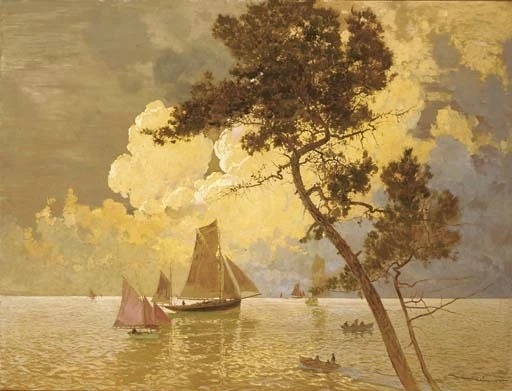

Amédée Julien Marcel-Clément
FR
49
Artworks
1873 - 1900
Lifespan
Artist Biography
Amédée Julien Marcel-Clément, born in Paris on September 15, 1873, was a distinguished French painter whose artistic journey began with formal training at the prestigious School of Fine Art. Despite being a lifelong resident of the French capital, a city teeming with artistic inspiration, Marcel-Clément chose to depict his native Paris in only a relatively small number of his works. His true passion and the eventual cornerstone of his reputation lay elsewhere, in the dynamic coastal landscapes and maritime scenes of France. He made his official debut in the Parisian art world in 1903 at the Salon de la Société Nationale des Beaux-Arts. Early in his career, he gained some recognition for his Parisian street scenes, which vividly captured the essence of the Belle Époque and the fashionable society of the time, showcasing his keen observational skills and ability to translate urban life onto canvas.
Throughout his career, Marcel-Clément remained a consistent and respected presence in the major Parisian Salons. He exhibited regularly at the Salon de la Société Nationale des Beaux-Arts, where he had first introduced his work, and also became a frequent contributor to the Salon des Indépendants, sending numerous paintings that highlighted his evolving style and thematic interests. His artistic reach extended beyond French borders between 1913 and 1914 when he presented his works in England. These international exhibitions included showings at the esteemed Walker Art Gallery in Liverpool and the Royal Scottish Academy, introducing his unique vision to a British audience and further solidifying his standing as an artist of note. This period likely coincided with his increasing dedication to marine subjects, which were becoming central to his artistic output.
The vast majority of Marcel-Clément's oeuvre is dedicated to the depiction of the French coasts and evocative scenes of maritime life. It was for these powerful and atmospheric seascapes that he became best known and highly celebrated. He held a particular affection for Dinard, a coastal commune in Brittany, where he maintained a second home. This location, with its dramatic cliffs and ever-changing seas, provided him with endless inspiration. His marines are renowned for their masterful capture of light, particularly the ethereal effects of light emanating from the sky and casting a thousand reflections upon the sea. This skillful manipulation of light allowed him to create atmospheres that were both intensely realistic and, at times, imbued with a profound sense of drama, drawing the viewer into the vastness and an elemental power of the ocean.
Marcel-Clément's technical approach was characterized by a sophisticated understanding of color and form. His palette often consisted of a nuanced variety of greys and blues, which he expertly interspersed with whites and creams. This carefully chosen color scheme enabled him to evoke the silvery, miroitante (shimmering) quality of both sky and sea, achieving a harmonious and often mesmerizing visual effect that captured the reflective interplay of light on water. He was adept at creating a mirror-like texture that conveyed the fluidity and depth of his marine environments. His works often demonstrate a delicate balance between observed reality and artistic interpretation, showcasing his ability to distill the essence of a scene.
The artist's style was further defined by his innovative use of simplified forms and surfaces that bordered on abstraction, yet paradoxically, these techniques allowed him to render elements like the sails of boats with surprising realism. Marcel-Clément also demonstrated a fondness for playing with contrasts, skillfully opposing firm, decisive brushstrokes and sombre values with more fluid, atmospheric passages and luminous reflections. This dynamic interplay added depth and tension to his compositions. A distinctive characteristic of his work is the chosen point of view, which consistently invites the spectator to project themselves into the scene, fostering an intimate connection with the depicted landscape. His compositions were often highly stylized and "savamment étudié" (skillfully studied or composed), reflecting a meticulous approach to his art, with some works even revealing a subtle "inspiration japonisante," suggesting an appreciation for the aesthetic principles of Japanese art in their balance and evocative simplicity.
Amédée Julien Marcel-Clément remained dedicated throughout his career to capturing the intrinsic atmosphere of his subjects with the utmost care and precision. He possessed a remarkable ability to convey complex moods and visual truths using relatively simple means and a restrained palette. This economy of technique, far from diminishing the impact of his work, resulted in compositions that are both profoundly truthful and stylistically sophisticated. While the year of his passing remains unknown, Marcel-Clément's legacy endures through his evocative paintings, particularly his luminous seascapes, which continue to resonate with audiences for their technical brilliance, atmospheric depth, and the unique way they capture the timeless dialogue between light, sea, and sky.